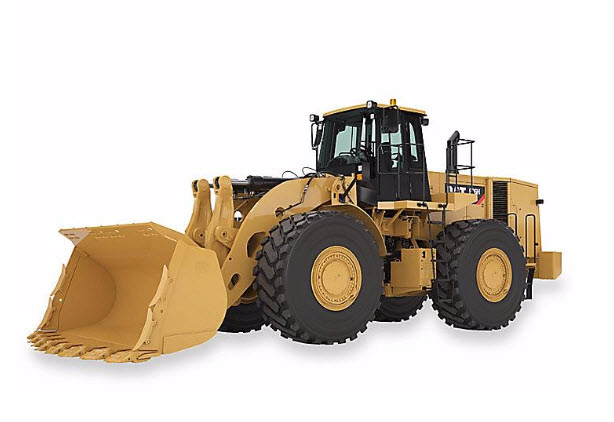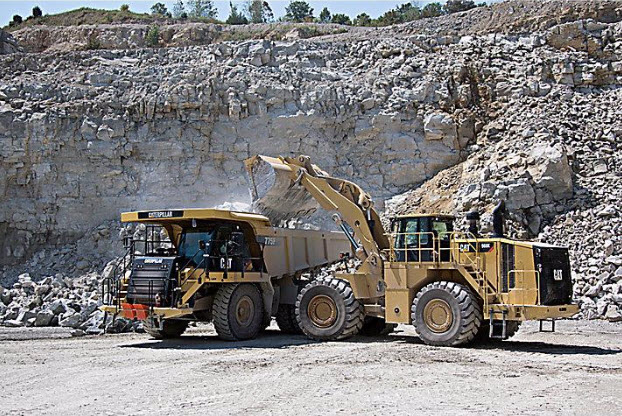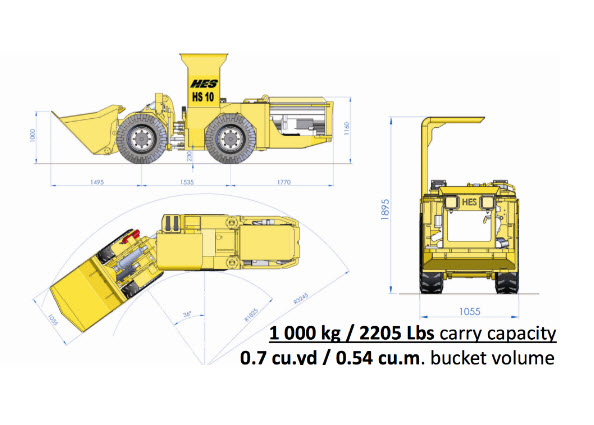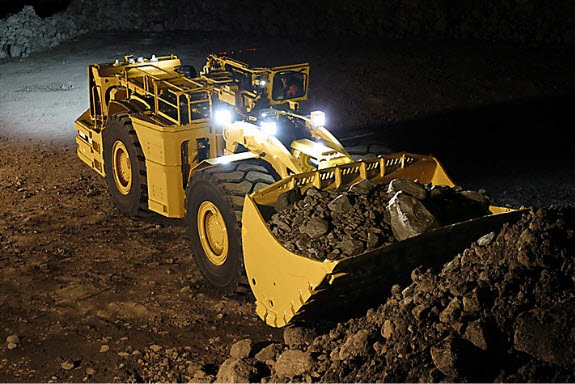5.1.1c: Wheeled Loaders, Scoops and LHDs
Wheeled loaders are mobile and maneuverable, and commonly found in surface and underground mining applications. The bucket typically ranges in size from a few yd3 to 10yd3. The high-lift linkage allows loading of the largest haul trucks available. These loaders are capable of digging soft and unconsolidated materials but are most commonly used for loading material that has been blasted. Chains are often put on the tires to increase the traction available, which allows the bucket to push more efficiently into piles of broken rock. In everyday use, they are often called loaders, rather than wheeled loaders.
Here we can see a very common use of the wheeled loader.
Next, let’s take a look at some loaders that are used exclusively underground. The amount of clearance available underground can be quite restrictive. While some underground mines will have openings that are approaching 100’ in height, less than 10’ is much more common. The equipment designed to operate in these confined spaces has to be designed quite differently to fit into these spaces and still be capable of doing something useful.
Scoops and LHDs (Load-Haul-Dump)
There are some differences between scoops and LHDs, but for the purpose of this discussion on loaders, we are not going to differentiate between the two other than to note that scoops are more likely to be used strictly for loading ore into an underground mine truck in metal mining, and that they are often used for moving supplies around in underground coal mines.
These machines are designed with a low profile to function in confined spaces. Moreover, they are often articulated, i.e., the machine is split into two parts and connected with an articulating joint. This allows the machine to turn and maneuver in tighter spaces. The scoop loader shown here illustrates the concept quite nicely. At less than 3-1/2’ wide, 6’ high, and 16’ long, it would easily fit inside of the bucket of many surface loaders! The bucket capacity of these machines ranges from just under 1 yd3 to 4 or 5 yd3.
Here is a picture of a typical LHD, which stands for Load-Haul-Dump. These machines are commonly used in underground metal mining and they push into a pile of broken ore (load) and then they haul (transport) their load to a dump point. The haul distances are relatively short – typically less than a 1000’, although this can vary. This LHD is available with bucket capacities ranging from 10 to 15 yd3.
When we talk about the underground metal mining methods, you will see the importance of LHDs in those operations.
This brief introduction to loaders is by no means exhaustive. There are still some legacy devices in use – overshot loaders and slushers, for example, in metal mining. However, here, we have covered the devices that account for virtually all tonnage produced in modern mining systems. This also brings to a close our discussion not only loaders but also ore winning, more or less. Wait a minute, more or less? Well mostly more… however, we have not talked about an important class of ore winning machines known as continuous miners, road headers, and shearers. We’ll do that in the next lesson. For now, we’re now ready to move into materials handling – the last unit operation in the production cycle of drill-blast-load-haul for hard rock or excavate-load-haul for soft rock.



